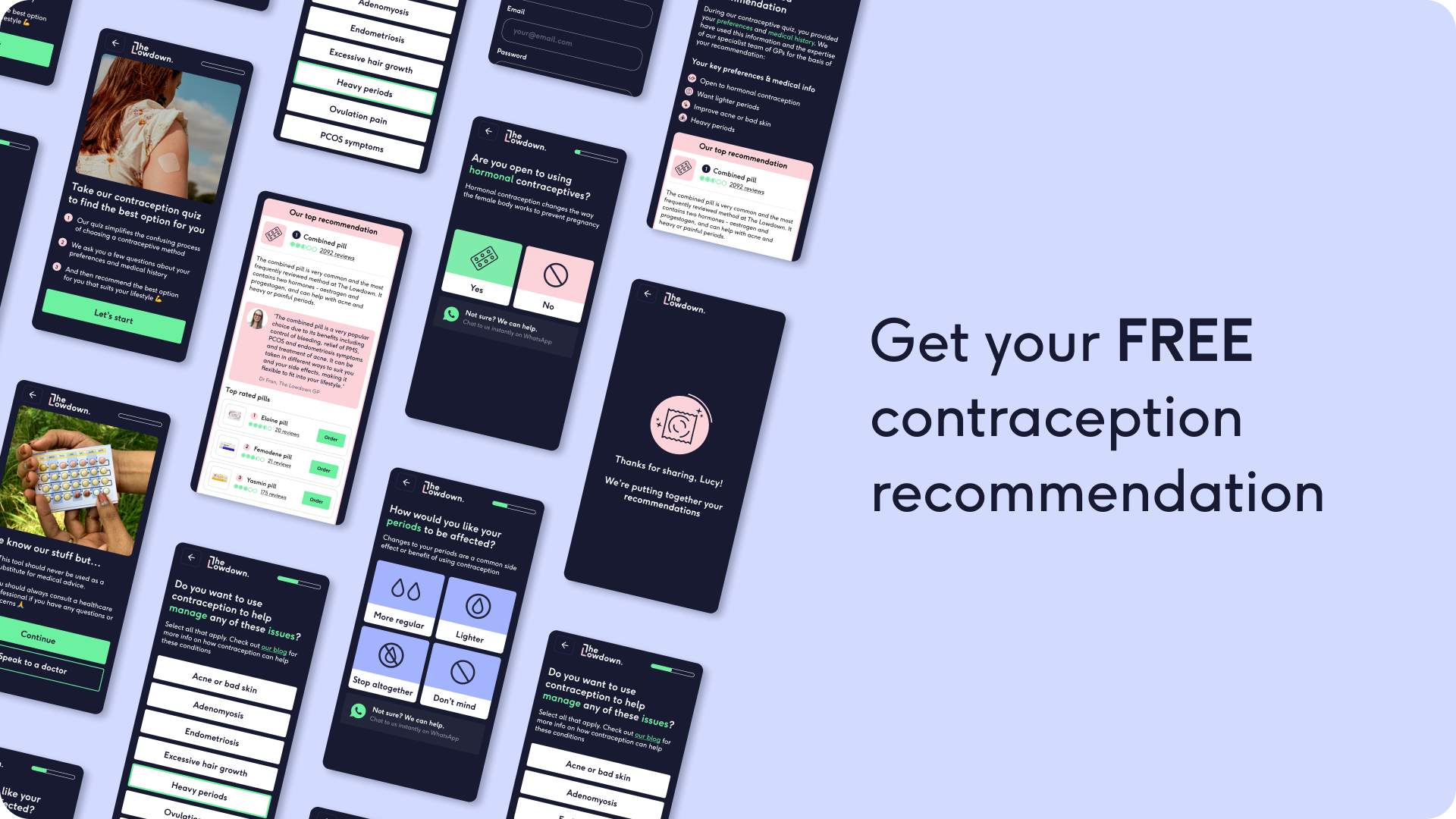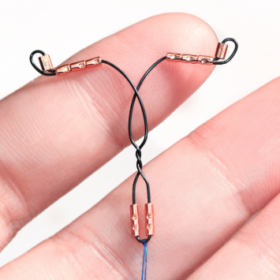
Talking to your partner about contraception, your menstrual cycle and shared responsibility
Disclaimer: This article is sponsored by Natural Cycles, but just like all of our other content, this is a completely honest breakdown. See our Content Policy for more details.
At The Lowdown we firmly believe that preventing unplanned pregnancy is a shared responsibility between partners – long term or otherwise. So, we’ve put together a guide on getting your partner clued up about your monthly cycle, when you’re actually most likely to get pregnant, and what they need to know about contraception and how it can affect you.
Why shared responsibility is important when it comes to contraception
Currently, all hormonal methods of contraception (and most non hormonal methods) that are available are intended for use by those of us with a uterus. Whether that’s taking a daily pill or tracking your monthly cycles. This has left a disproportionate weight – or burden – on women and people with vaginas to ensure effective use of contraception to prevent pregnancy. While there are some promising developments in male contraception, including a non-hormonal male contraceptive pill, many are still in trial stages and a long way off from being widely available. In the meantime, any partners you have should probably be taking an interest in what’s going on inside your body if you’re both aiming to avoid pregnancy.
So, how does the menstrual cycle work?
If you’re not totally clued up yourself on how the menstrual cycle works, let alone your partner, we’ve got you covered. There’s more to it than just ovulating (when the ovaries release an egg) a few days a month, as the menstrual cycle has two distinct phases, before ovulation and after:
- The follicular phase before ovulation is signalled by the start of your period which is considered ‘day 1’ of your cycle. This is when the uterus is preparing for ovulation by getting the womb lining in peak condition for implantation of a fertilised egg.
- During ovulation, a mature egg is released into the fallopian tube, staying around for 12-24 hours. This is when you’re at your most fertile, and the egg will either be fertilised by sperm, or flushed out of the body if not.
- The luteal phase, after ovulation, maintains the womb lining in case an egg is fertilised so it can implant in the womb lining, resulting in pregnancy. Otherwise, the womb lining breaks down and the cycle begins again.
Why is it useful for your partner to understand how your cycle works?
Both you and your partner can use signs of ovulation, such as changes in body temperature and the days of your menstrual cycle, to work out when you will ovulate and therefore when you’re most likely to be fertile. This is the basis for fertility awareness methods (FAM) of contraception, also known as natural family planning. You can learn to do this with a fertility awareness practitioner the old fashioned way, or use the Natural Cycles app to work this out for you. This allows you to know when your fertile days are and when additional contraception like condoms are needed, and also your non fertile days where unprotected sex is allowed!
It’s important to remember the withdrawal method, also known as the pull out method, is only 80 to 90% effective (which sounds like a lot, but this is way less than other contraceptives, and leaves a 10 to 20% chance of unintended pregnancy!). The withdrawal method is not considered a reliable method of contraception on its own, but can be used in addition to other effective methods of contraception and could be used alongside the Natural Cycles app on ‘green’ non-fertile days.
Talking to a new partner about contraception
Every time you have a new sexual partner, it’s a good idea to have a chat about contraception if you don’t want to get pregnant, or contract a sexually transmitted infection (STI). This could be a simple ‘I’m on the [insert chosen method]’, or, ‘we need to use a condom’, before you have sex. If contraception comes up at any point, you could explain more about why you use a particular method over others. Condoms are the only contraceptive that can help to protect you from STIs; so ask when your new partner last had an STI test, and let them know if you’re up to date on screening too. If you’ve communicated that you want to use a condom, and they either refuse, try to talk you out of it, or remove it without your consent – this is an example of reproductive coercion, and a big red flag.
If you use FAM or Natural Cycles, this is actually a great talking point. Explain how it works, and the risks of getting pregnant if using FAM , so together you can also make an informed decision about whether you’d like to use additional contraception such as condoms, even if you’re at a non-fertile stage of your cycle when you plan to have sex.
When it comes to new partners, communicating about your sexual needs as well as contraception is key. Don’t be embarrassed to use lube (hormonal contraception can cause vaginal dryness as a side effect), and let them know what you like in bed – no one wants to fake an orgasm. If you have anxiety around sex, including problems reaching orgasm, check out our sex coaching advice service and watch our webinar on sex, libido and orgasms for top tips to help you enjoy sex.
Talking to a long-term partner about contraception
If you’re in a long-term relationship, the conversation around contraception and shared responsibility might need to stretch a bit further than letting them know what method you’re using. Here’s some things to think about…
Choose a method that suits your lifestyle
Sit down with your partner and have a chat about your life together – what do you get up to day-to-day, and how often do you have sex? If you frequently have sex, are you less likely to want to use a contraceptive you need to remember at the time, or on a daily basis?
If you’re often busy, or have an irregular routine, taking the pill or using FAM to track your temperature everyday might not work for you. Remember, no contraceptive is 100% effective, but methods that heavily rely on you using them consistently and effectively leave more room for human error, which you and your partner may want to take into consideration if you are not trying to conceive.
If you’re not using any contraception other than condoms and are prone to risk taking in the heat of the moment, this method may also be less effective in the long term. Whether one or both of you hate condoms, or hate having to remember to buy them (and the ongoing cost of using them), there are plenty of long-lasting methods that you may prefer. Check out our guide to non hormonal contraception if you would rather not use hormonal methods.
Experiencing negative side effects
While hormonal contraception can have many benefits aside from birth control (like helping with painful periods or acne), some people who use hormonal contraception report negative side effects. If you experience mood swings or low sex drive that affects your daily activities or relationship, it’s understandable that you’d want to stop or switch your contraception to find an alternative that works for you. When talking about this with your partner, make sure they really listen to your concerns, and how you feel it could be affecting your relationship. If they’re not happy about switching back to condoms for a while (or permanently) because it ‘doesn’t feel good’, remind them that in 9 months they could have a lot more to worry about.
If you’re having trouble finding a method that works for you, try our contraception recommender, or chat to one of our friendly women’s health GPs for advice.

Whether you want to have kids
If you’re both on the same page about not wanting kids, or any more than you’ve already got, you may want to consider the two permanent contraception options: the vasectomy or female sterilisation (aka getting your ‘tubes tied’). Names out of a hat to decide who wins? Or, a grown up conversation about who’s willing to have a surgical procedure and the different risks involved, it’s up to you.
If permanent contraception doesn’t appeal to either of you, long-acting reversible contraception (LARCS) such as the hormonal coil (IUS) or implant are very reliable ‘set it and forget it’ options that can be removed at any time. The implant is actually even more effective than a vasectomy! If you’re not a fan of hormonal methods, the copper coil (IUD) could be a suitable option.
Getting pregnant soon after stopping contraception
There is evidence to suggest that it can take a while for your fertility to return after using the contraceptive injection over other methods like the pill or coils for example, so this is something to think about if you’re already discussing family planning. Natural Cycles also has a pregnancy planning mode, so if you’re using this method of contraception already you can easily transition into trying to conceive, and then even track the changes happening to your body throughout pregnancy.
Keeping them in the loop
Your partner can help to make sure you take your pill, patch or ring at the right time or date to ensure your contraception is as effective as possible. Mark the changeover dates on a shared calendar, ask them to also set a daily pill alarm or give you a gentle nudge if they know you may have forgotten. Keep them in the loop if you’re using it continuously to skip your period, too. The injection has a longer time between top-ups (8-13 weeks depending on the type), but it can’t hurt to let them know when this needs to be done too.
Using FAM and Natural Cycles to plan quality time
Got some non-fertile days coming up? Make plans to have alone time and do some fun activities together, all the better when you know you can enjoy some unprotected sex after! Know when your fertile days are? Then there’s no excuse for them not to have condoms when you see each other, or help keeping your supply well stocked if you live together.
Shared responsibility and Natural Cycles
We know lots of you love using Natural Cycles as a way of getting to know your body, so shouldn’t your partner love it for that reason too? If you’re unfamiliar with how it works, our guide to Natural Cycles has the complete lowdown on the app, including everything you need to know about the intuitive algorithm.
Natural Cycles have launched a ‘Partner View’ feature that allows you to share insights about your cycle with your partner, or anyone else you grant permission to (in case you fancy letting your mum know when you’re fertile). You can choose specific insights that you want to share, if you even want to at all – it’s completely optional. What are the benefits? Well, sharing your Natural Cycles fertility status with your partner so they can clearly see your ‘red’ fertile days and ‘green’ non-fertile days could not only help them to be more in tune with your body, but also make them more conscious of avoiding unnecessary risks if you don’t want to get pregnant (remember what we said earlier about the withdrawal method).
But that’s not all. As well as keeping an eye on your fertile and non-fertile days, you can log insights about your period and PMS symptoms, like mood swings, sex drive, cramps and pain, or any other symptoms or illnesses you experience throughout the month. Sharing this with your partner can help them understand exactly how your cycle affects you, not just the science of it all. They can see when you’re anxious, moody or in pain during your period, and check in with you to (hopefully) provide some emergency chocolate, painkillers and quality time!
Should we split the cost of contraception?
While you can get most contraception for free on the NHS, sometimes you may need or want to buy it elsewhere, especially if you’re in a hurry. When it comes to the morning after pill, there’s no harm in asking them to split the cost – it takes two, after all, and why should it be any different than splitting the cost of dinner on a date? If you’re in a long-term relationship and use condoms, why not take it in turns to buy a box?
As Natural Cycles is a digital contraceptive, an annual membership costs £59.99 with a thermometer included, or £8.99 per month (plus a one-off £10 cost for the thermometer). But in the name of shared responsibility, would your partner consider splitting it? Think of it as a shared Netflix subscription for your vagina. If you do want to try out Natural Cycles for yourself, Lowdown readers can receive 15% off an annual subscription and a free thermometer using this link (or the code LOWDOWN15).*
*FYI – this is an affiliate link, which means The Lowdown will earn a commission on any purchases made. If you have any questions about this, drop us a message!
Our medical review process
This article has been medically reviewed for factual and up to date information by a Lowdown doctor.







